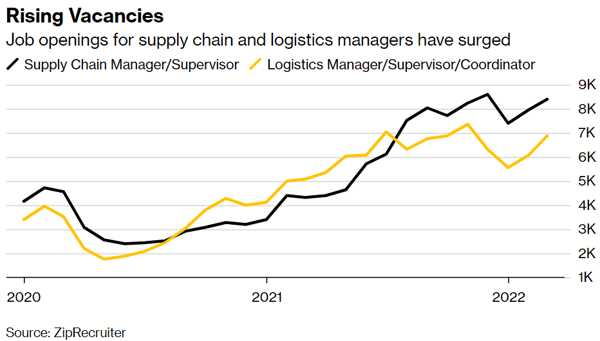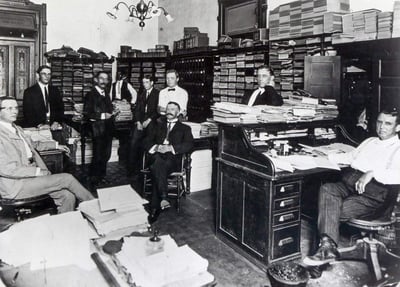Burnout, stress and desire for higher pay all contributed to 2021 seeing the highest rate of supply chain manager resignations since 2016. While the American office has been around for over 100 years, a unique set of triggers is leading to burnout previously never seen at the national level. Bloomberg worked with LinkedIn to determine that the average separation rate for supply chain managers increased by a whopping 28% over the previous year.
All the issues we’ve been talking about here for months – pandemic pandemonium, facility shut-downs, port congestion, driver shortages, and rising transportation costs – contribute to the burnout. But the flip side is new opportunities for seasoned professionals who can deal with the ongoing supply-chain disruptions. Many of them end up at 3PLs like IL2000.
“With increasing opportunities against the backdrop of the supply chain crisis, it comes as no surprise that supply-chain managers have increasingly sought out greener pastures,” said Kory Kantenga, a senior economist at LinkedIn.
The table below from ZipRecruiter shows a doubling in supply chain manager vacancies between January 2020 and March this year. Julia Pollak, the company’s chief economist, attributes the rise in vacancies to companies creating more positions to deal with the crisis and because labor shortages gave workers more leverage to switch jobs.
How did this happen? We’ve been staring empty shelves in the face for months, actually years. Everything companies knew about staffing, supply chains and logistics worked against them as Covid-19 brought waves of excessive orders (but we've heard enough about toilet paper by now) and lulls in supply (the automotive industry is still a long way from meeting pre-chip shortage production).
This volatility and unchartered territory had supply chain managers pulling their hair out. Problem-solving took on a whole new dimension.
This is where veteran logistics personnel and 3PLs turn to data and Business Intelligence. While limited data collection contributes to bottlenecks, it is failure to analyze the figures and provide insights that hampers supply chain management. We’d go a step further and say that failing to act on BI doesn’t just hamper supply chain management, it entrenches a state of uncontrollable disruption.
This scenario creates a dilemma for companies. To keep growing and competing, a business needs responsive solutions and a far-seeing perspective built on sturdy data foundations. Building such formidable BI machinery requires a team of supply chain professionals with years of industry experience. Meanwhile, every competitor under the sun wants precisely the same people for precisely identical reasons.
How to bust that impasse? Many hard-pressed companies are turning to 3PLs to deliver the logistics equivalent of greased lightning in a quick-open bottle.
How do you know if a 3PL is right for you?
Culture at the office…and the history of railroads in America.
This wouldn’t be an IL2000 blog without veering onto a historical trajectory. So, let’s take a backward glance into history before we look to the future of how teams work together.
The logistics freedom offered by the arrival of the railroad in early nineteenth-century America gave birth to the American Office and changed commerce forever. Before that time, a merchant faced his own scarcity dilemma, acting as the importer/exporter/banker/wholesaler/retailer/shipowner for locally focused companies. He may have a clerk or two helping with the ledger book, but when it came down to it, a merchant’s trade was a one-man show.
Then the steam train revolution arrived. (Photo: An Early American Train, Circa 1850 by Everett.)
Once steam trains connected the states coast to coast, goods could be transported anywhere, and commerce expanded westward. Business became national, and those local merchants were no longer doomed to handling local business alone. As the business stakes increased, so did the logistics.
The railroad became a multimillion-dollar corporation well beyond anything the mom-and-pop companies could have imagined previously. For the first time in American history, a network of employees in offices all across the country handled roles from ticket sales and engineering to payroll. A vast interoffice communication system was born. (Photo: Engineering Division of the Railroad Commission office, Texas, 1900s.)
 Companies like Western Union, the banking industry and insurance companies modeled this organization and hierarchy until two hundred years and multiple layers of management hierarchy later, we have the office landscape we recognize today.
Companies like Western Union, the banking industry and insurance companies modeled this organization and hierarchy until two hundred years and multiple layers of management hierarchy later, we have the office landscape we recognize today.
When the global pandemic hit, office mobility and remote communication technologies like Zoom (the hyper great-great-grandchild of the telegraph) were critical factors in allowing a large majority of the workforce to "work from home."
Now, the line between in-house and outsourced is faint. The extreme flexibility and resiliency of work teams embrace expertise and help wherever it can be found. The face of your 3PL's Operations Account Manager located in Virginia Beach is as familiar as the Zoom persona of your Purchasing Manager in Seattle.
Outsourced help is easier to incorporate into your corporate culture today than ever before in the history of supply chains.
How do you know if a 3PL is right for you?
When evaluating if a 3PL could support your supply chain, here are a few things to consider.
Do you continue to invest in your team? Training, higher wages, and recruiting a team with the drive to bring innovation and results? Here’s why that’s difficult.
The talent gap has been a supply chain issue for the past nine years, according to the 2022 MHI Annual Industry Report, so you may find it a sound business decision to partner with a 3PL and let them provide the expert consultants and supply chain managers.
Likewise, if your organization is small, perhaps hiring a supply chain manager with the necessary experience and ability will be part of your future plan, but until then, outsource a team to close the gap. As discussed above, processes that worked well in pre-pandemic times are on shaky ground today. A company that can't evolve faces Darwin-esque extinction.
Are you prepared to scale and innovate your processes?
It’s a lot to expect your team to book shipments while proficiently analyzing and acting on data to future-proof your supply chain at the same time. 3PLs have BI teams dedicated to customizing the tools you need, presenting insights and recommending evolution in your processes to keep your business alive.
Technology is an enabler, not a hindrance. But trying to manage a TMS or logistics software yourself and keep it meeting your needs as the market changes may take more time, capital, and dedicated personnel than you can allocate. Even if a tech company sells you a “base solution,” your team will have to run it.
With a robust, scalable, and customized TMS from a 3PL like IL2000, you’ll achieve enhanced visibility and greater control over your supply chain – without needing an in-house team of IT experts.
IL2000 wants to help you make the right decision.
Pioneering doesn't stop; it refocuses
Even a few years ago, you could get your product from A to B efficiently enough to stay in business with just a handful of operators and a traditional playbook. Businesses could get away with running a simple, linear supply chain.
A lot has changed. Supply chain management is evolving.
The market has become more interconnected and complex as finite resources jostle players into fierce competition. In this changing landscape, resignations abound. Turbulence is the rule, not the exception, and a lack of the right logistics management expertise at the wrong time can spell disaster -- thwarting your growth at every turn.
Bust out of the dilemma. Innovative businesses craft bold solutions. Working with a 3PL can be that pure, bright, bottled lightning solution that propels you into a whole new frontier of supply chain management.
Schedule a conversation about your future today.

